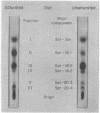Abstract
Several aspects of the effects of dietary fat on plasma lipids and lipoproteins were investigated in 12 subjects during the long-term feeding of formulas containing 40% of their calories as either saturated or unsaturated fats. The changes in fatty acid composition of plasma lipids, shown previously to occur after prolonged feedings of a dietary fat, required 10-14 days to be complete and were synchronous with the effect of the fat on plasma lipid concentrations. The change in lipid concentration occurred in low but not in high density lipoproteins. The effects on lipid levels of the low density lipoproteins were found to occur with little or no effect on the concentration of the protein moiety of these lipoproteins; as a result, cholesterol- and phospholipid to protein ratios in low density lipoproteins fell during unsaturated fat feeding. The effects of dietary fat on plasma phospholipids were studied in detail: the relative amounts of phosphatidylcholine, phosphatidylethanolamine, sphingomyelin, and lysophosphatidylcholine were unaffected by the type of dietary fat. However, the molecular species of phosphatidylcholine were markedly affected. More than 90% of the fatty acids at the α-position were saturated during both saturated and unsaturated feedings. In contrast, during unsaturated feedings, linoleate at the β-position outnumbered oleate by approximately 4:1, whereas during saturated feedings these two types of fatty acids were present in nearly equal amounts.
This paper also presents the following hypothesis for the lipid-lowering effect of unsaturated dietary fat: since unsaturated fatty acids occupy a greater area than saturated acids, they alter the spatial configuration of the lipids into which they are incorporated; as a result, fewer lipid molecules can be accommodated by the apoprotein of the low-density lipoproteins (LDL), and thus the lipid content of the lipoprotein is lowered. The experimental findings of this study, while not proving this hypothesis, are consistent with it.
Full text
PDF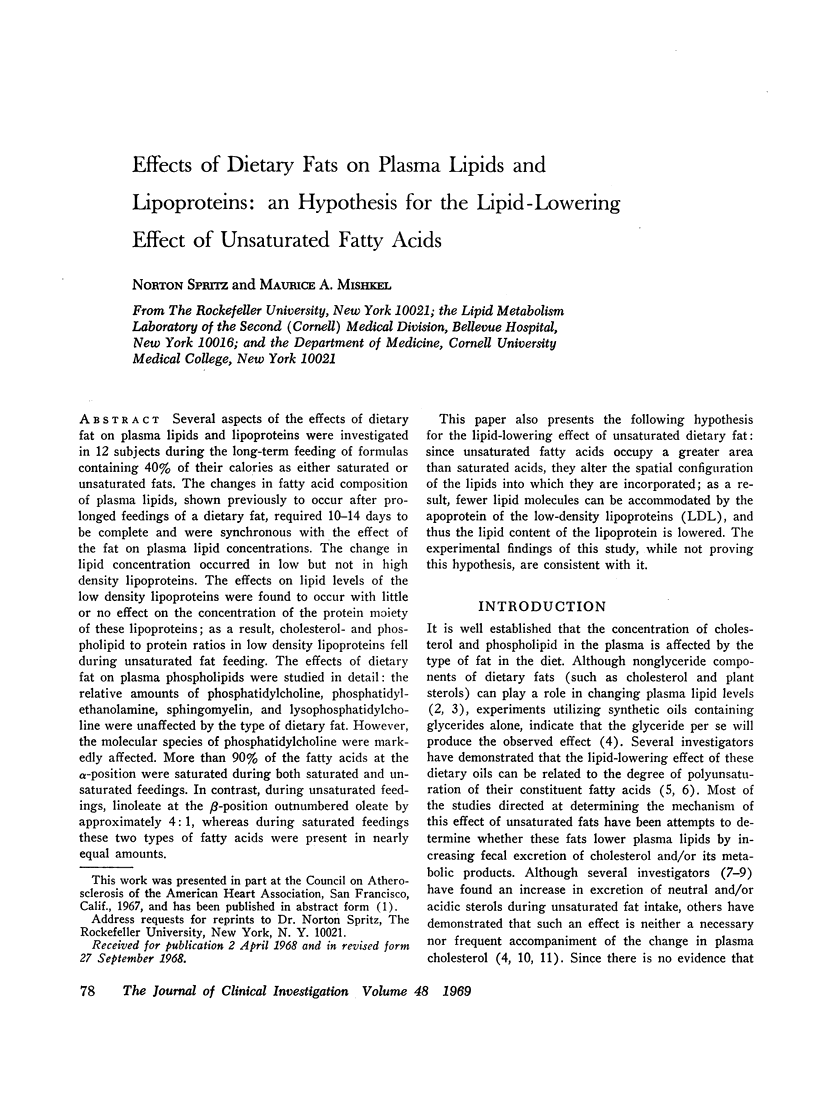
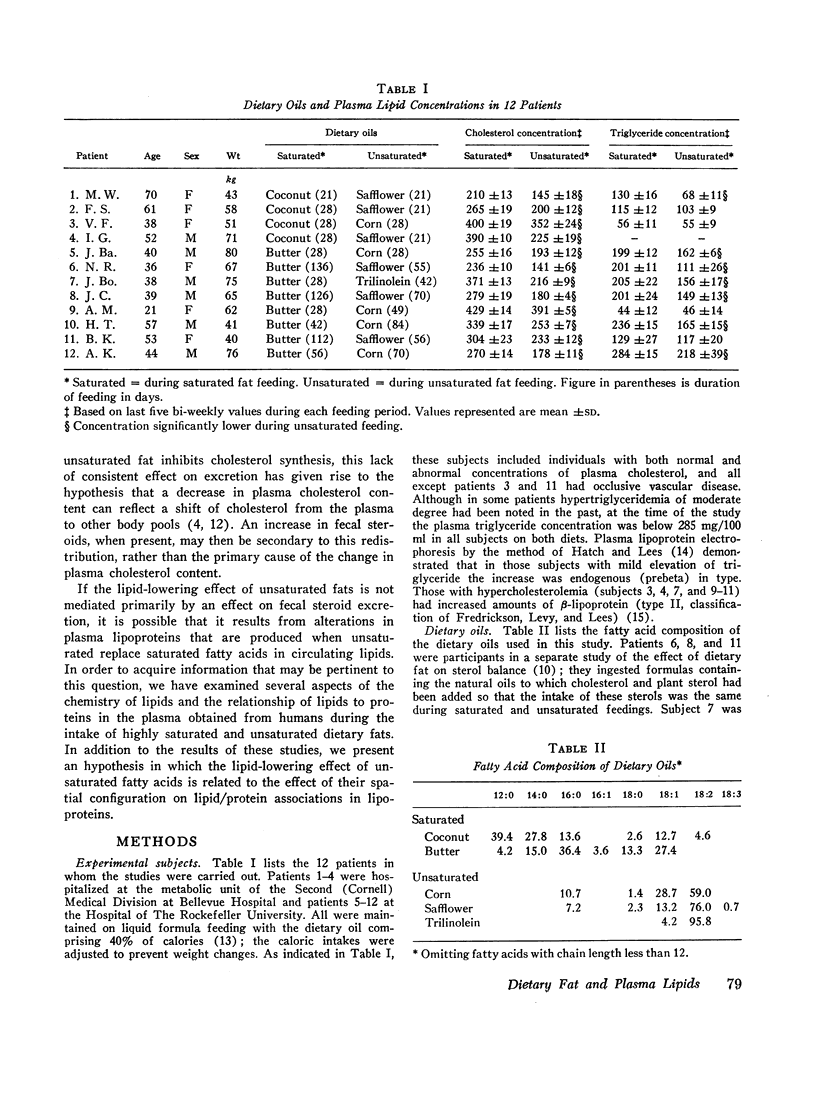
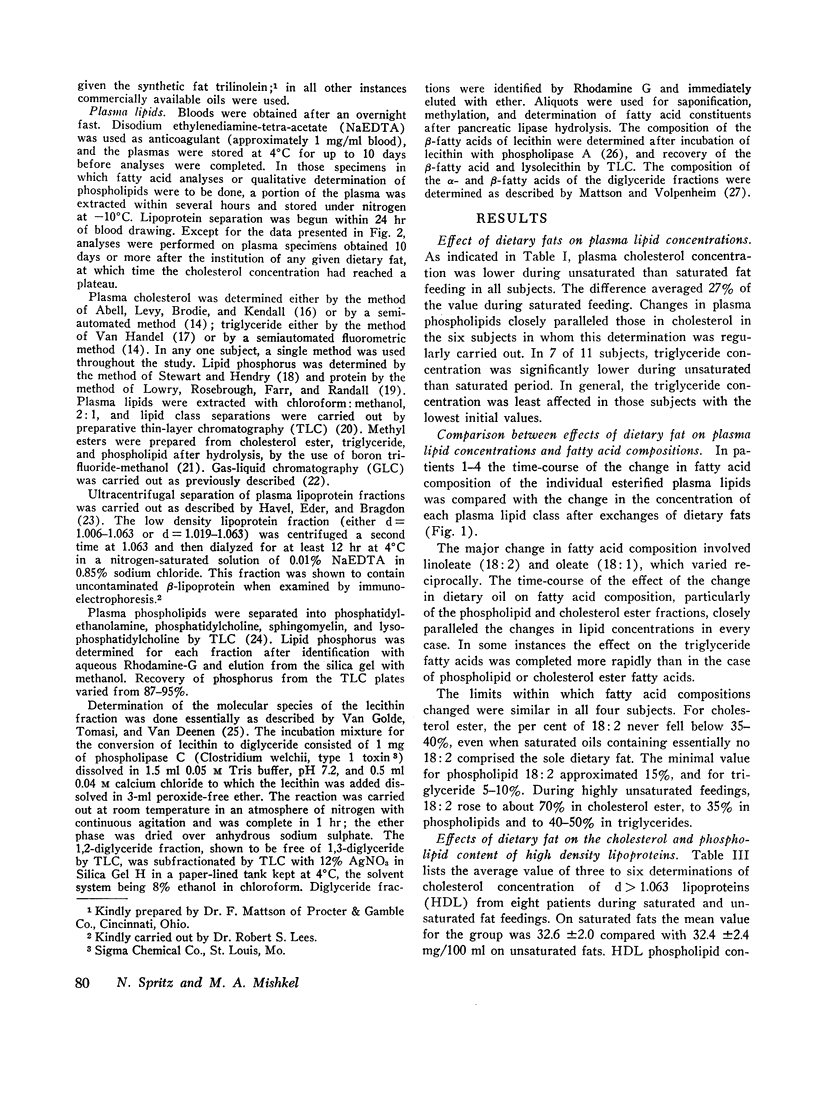
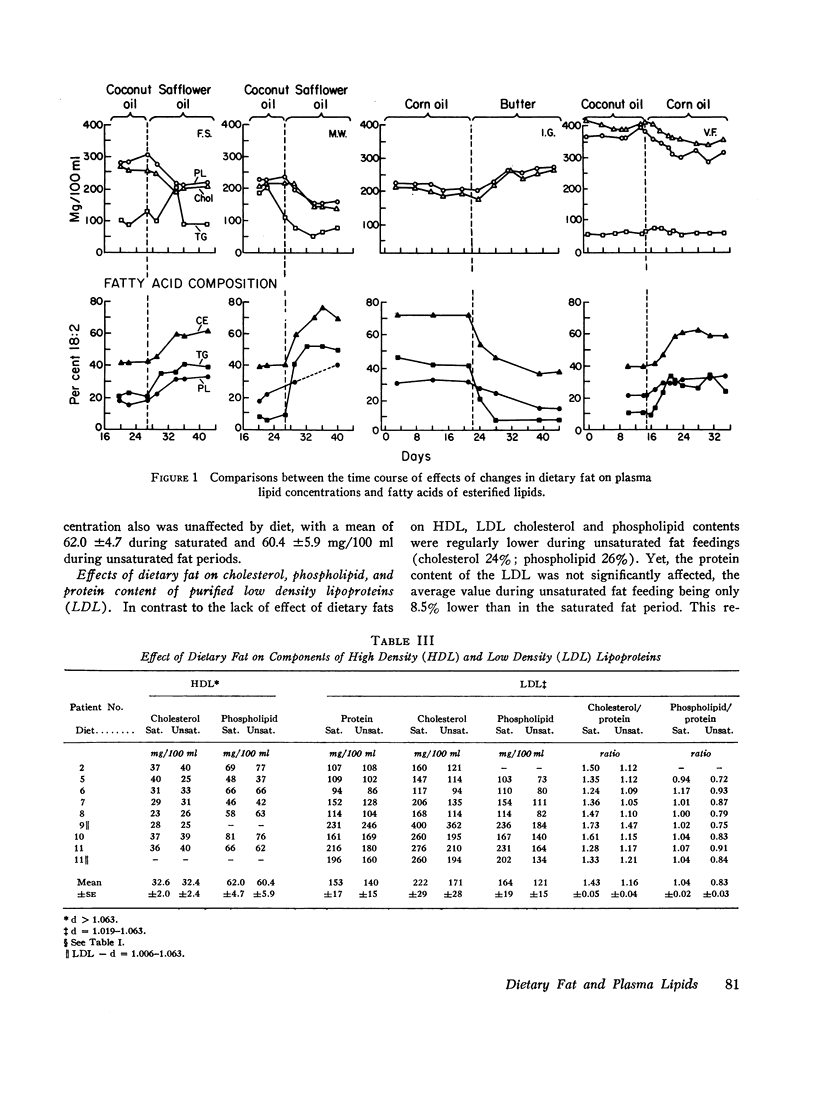


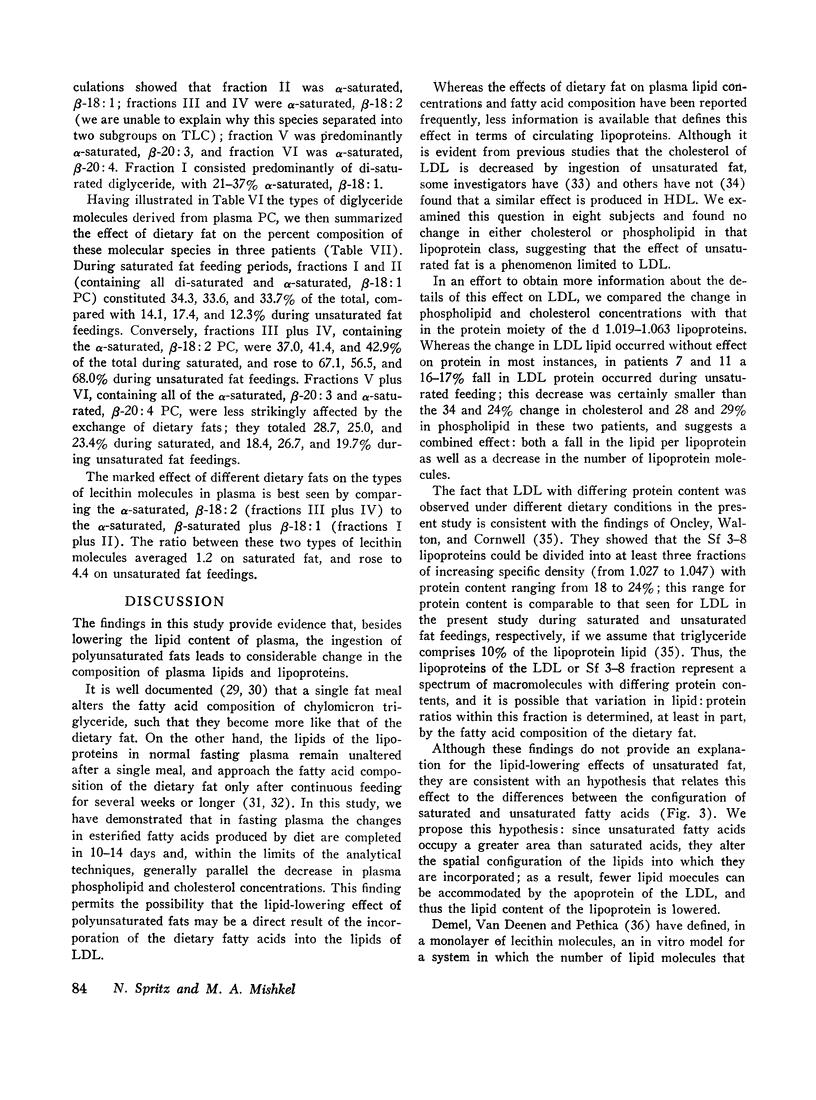
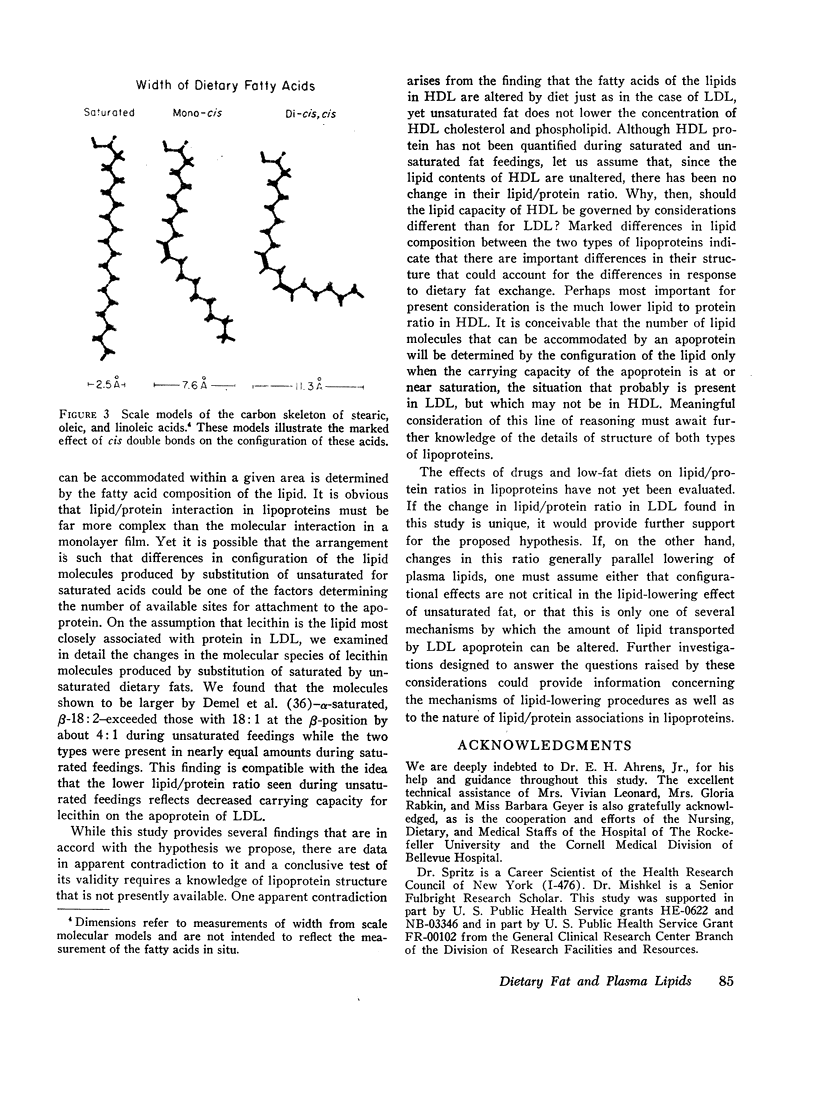

Images in this article
Selected References
These references are in PubMed. This may not be the complete list of references from this article.
- ABEL L. L., LEVY B. B., BRODIE B. B., KENDALL F. E. A simplified method for the estimation of total cholesterol in serum and demonstration of its specificity. J Biol Chem. 1952 Mar;195(1):357–366. [PubMed] [Google Scholar]
- AHRENS E. H., Jr, DOLE V. P., BLANKENHORN D. H. The use of orally-fed liquid formulas in metabolic studies. Am J Clin Nutr. 1954 Sep-Oct;2(5):336–342. doi: 10.1093/ajcn/2.5.336. [DOI] [PubMed] [Google Scholar]
- AHRENS E. H., Jr, INSULL W., Jr, BLOMSTRAND R., HIRSCH J., TSALTAS T. T., PETERSON M. L. The influence of dietary fats on serum-lipid levels in man. Lancet. 1957 May 11;272(6976):943–953. doi: 10.1016/s0140-6736(57)91280-1. [DOI] [PubMed] [Google Scholar]
- AHRENS E. H., Jr, INSULL W., Jr, HIRSCH J., STOFFEL W., PETERSON M. L., FARQUHAR J. W., MILLER T., THOMASSON H. J. The effect on human serum-lipids of a dietary fat, highly unsaturated, but poor in essential fatty acids. Lancet. 1959 Jan 17;1(7064):115–119. doi: 10.1016/s0140-6736(59)90002-9. [DOI] [PubMed] [Google Scholar]
- Avigan J., Steinberg D. Sterol and bile acid excretion in man and the effects of dietary fat. J Clin Invest. 1965 Nov;44(11):1845–1856. doi: 10.1172/JCI105292. [DOI] [PMC free article] [PubMed] [Google Scholar]
- BEVERIDGE J. M., CONNELL W. F., MAYER G. A. The nature of the substances in dietary fat affecting the level of plasma cholesterol in humans. Can J Biochem Physiol. 1957 Apr;35(4):257–270. [PubMed] [Google Scholar]
- BLOMSTRAND R., DAHLBACK O. L. The fatty acid composition of human thoracic duct lymph lipids. J Clin Invest. 1960 Jul;39:1185–1191. doi: 10.1172/JCI104133. [DOI] [PMC free article] [PubMed] [Google Scholar]
- Bieberdorf F. A., Wilson J. D. Studies on the mechanism of action of unsaturated fats on cholesterol metabolism in the rabbit. J Clin Invest. 1965 Nov;44(11):1834–1844. doi: 10.1172/JCI105291. [DOI] [PMC free article] [PubMed] [Google Scholar]
- CONNOR W. E., STONE D. B., HODGES R. E. THE INTERRELATED EFFECTS OF DIETARY CHOLESTEROL AND FAT UPON HUMAN SERUM LIPID LEVELS. J Clin Invest. 1964 Aug;43:1691–1696. doi: 10.1172/JCI105044. [DOI] [PMC free article] [PubMed] [Google Scholar]
- FARQUHAR J. W., SOKOLOW M. Response of serum lipids and lipoproteins o man to beta-sitosterol and safflower oil; a longterm study. Circulation. 1958 May;17(5):890–899. doi: 10.1161/01.cir.17.5.890. [DOI] [PubMed] [Google Scholar]
- Grundy S. M., Ahrens E. H., Jr An evaluation of the relative merits of two methods for measuring the balance of sterols in man: isotopic balance versus chromatographic analysis. J Clin Invest. 1966 Sep;45(9):1503–1515. doi: 10.1172/JCI105457. [DOI] [PMC free article] [PubMed] [Google Scholar]
- HALLGREN B., STENHAGEN S., SVANBORG A., SVENNERHOLM L. Gas chromatographic analysis of the fatty acid composition of the plasma lipids in normal and diabetic subjects. J Clin Invest. 1960 Sep;39:1424–1434. doi: 10.1172/JCI104162. [DOI] [PMC free article] [PubMed] [Google Scholar]
- HAVEL R. J., EDER H. A., BRAGDON J. H. The distribution and chemical composition of ultracentrifugally separated lipoproteins in human serum. J Clin Invest. 1955 Sep;34(9):1345–1353. doi: 10.1172/JCI103182. [DOI] [PMC free article] [PubMed] [Google Scholar]
- Hatch F. T. Practical methods for plasma lipoprotein analysis. Adv Lipid Res. 1968;6:1–68. [PubMed] [Google Scholar]
- KAYDEN H. J., KARMEN A., DUMONT A. ALTERATIONS IN THE FATTY ACID COMPOSITION OF HUMAN LYMPH AND SERUM LIPOPROTEINS BY SINGLE FEEDINGS. J Clin Invest. 1963 Sep;42:1373–1381. doi: 10.1172/JCI104821. [DOI] [PMC free article] [PubMed] [Google Scholar]
- LOWRY O. H., ROSEBROUGH N. J., FARR A. L., RANDALL R. J. Protein measurement with the Folin phenol reagent. J Biol Chem. 1951 Nov;193(1):265–275. [PubMed] [Google Scholar]
- Lieber C. S., Spritz N., DeCarli L. M. Role of dietary, adipose, and endogenously synthesized fatty acids in the pathogenesis of the alcoholic fatty liver. J Clin Invest. 1966 Jan;45(1):51–62. doi: 10.1172/JCI105323. [DOI] [PMC free article] [PubMed] [Google Scholar]
- Nichaman M. Z., Sweeley C. C., Olson R. E. Plasma fatty acids in normolipemic and hyperlipemic subjects during fasting and after linoleate feeding. Am J Clin Nutr. 1967 Oct;20(10):1057–1069. doi: 10.1093/ajcn/20.10.1057. [DOI] [PubMed] [Google Scholar]
- Nutter L. J., Privett O. S. Phospholipase a properties of several snake venom preparations. Lipids. 1966 Jul;1(4):258–262. doi: 10.1007/BF02531612. [DOI] [PubMed] [Google Scholar]
- SPRITZ N., AHRENS E. H., Jr, GRUNDY S. STEROL BALANCE IN MAN AS PLASMA CHOLESTEROL CONCENTRATIONS ARE ALTERED BY EXCHANGES OF DIETARY FATS. J Clin Invest. 1965 Sep;44:1482–1493. doi: 10.1172/JCI105255. [DOI] [PMC free article] [PubMed] [Google Scholar]
- SRIBNEY M., KENNEDY E. P. The enzymatic synthesis of sphingomyelin. J Biol Chem. 1958 Dec;233(6):1315–1322. [PubMed] [Google Scholar]
- Skipski V. P., Barclay M., Barclay R. K., Fetzer V. A., Good J. J., Archibald F. M. Lipid composition of human serum lipoproteins. Biochem J. 1967 Aug;104(2):340–352. doi: 10.1042/bj1040340. [DOI] [PMC free article] [PubMed] [Google Scholar]
- Stewart C. P., Hendry E. B. The phospholipins of blood. Biochem J. 1935 Jul;29(7):1683–1689. doi: 10.1042/bj0291683. [DOI] [PMC free article] [PubMed] [Google Scholar]
- VAN HANDEL E. Suggested modifications of the micro determination of triglycerides. Clin Chem. 1961 Jun;7:249–251. [PubMed] [Google Scholar]
- Wood P. D., Shioda R., Kinsell L. W. Dietary regulation of cholesterol metabolism. Lancet. 1966 Sep 17;2(7464):604–607. doi: 10.1016/s0140-6736(66)91924-6. [DOI] [PubMed] [Google Scholar]



